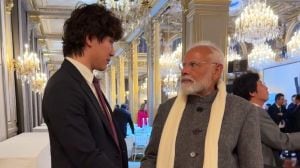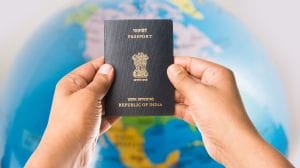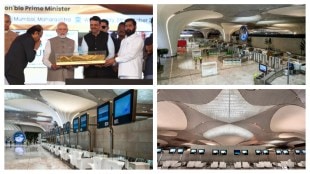A striking six-foot-high sculpture resembling a motorcycle helmet and crafted from mycelium, an innovative organic material, stands tall at the entrance of Travancore Palace in the national capital, which is hosting the 10-day multidisciplinary festival, Journeying Across the Himalayas.
Titled Helmeted Hyphae and created by an urban contemporary art collective XXL, the helmet is one of a dozen-odd artworks crafted as part of Royal Enfield’s partnership with a not-for-profit Helmets For India, and India Foundation for the Arts, with the sole aim of bringing road safety initiative and forcing helmet usage.
From a helmet covered with face masks, another designed with mobile tempered glass to one that paints a connection with nature, 12 artists are part of this exhibition who have transformed helmets into unique creative expressions reflecting personal stories, gender journeys, and memories of bike rides.
“It’s a canvas for self-expression, bringing together the global motorcycling community through custom-built helmets, and raising awareness about safe riding,” says Bidisha Dey, executive director of Eicher Group Foundation that supports the motorcycle community through its CSR programmes.
Helmeted Hyphae is one of many such creative forms of expressions showcased at the very first edition of the festival this year. Organised by Eicher Group Foundation, Royal Enfield’s social mission, the Himalayan region’s rich cultural and natural heritage bring in some engaging community conversations, curated cuisine, live music and storytelling from over 100 Himalayan communities and 200 creative practitioners with a vision to build resilience against climate change.
“We are here to catalyse a global movement of one million riders who will become agents of change in the region as we feel the fragile Himalayan ecosystem must be preserved,” adds Dey.
Among a few crafts and communities that are relevant and represented across the region, as part of the mega showcase, Dey feels these have worked tirelessly for a few years to represent their valued crafts. A community of wool knitters from Lahaul and Spiti weave visually compelling runners telling stories through warp and weft. A multimedia showcase of the shepherd from the Gaddi, a semi-pastoral tribe from Himachal Pradesh and Jammu and Kashmir, who laments the decline of herding in the valley with only a few continuing the tradition. Artists like Raghava KK’s distinctive style, the central installation pulses with vivid, textured visuals — rare species, intricate flora, mythical creatures, and hidden artefacts emerge and fade, creating moments of surprise, connection, and contemplation. These elements reflect the fragility and resilience of Himalayan ecosystems and culture, while The Long Road by multimedia artist Vishal K Dar is a showcase of facilities like sanitation, tourist information, basic first aid, planned across popular traveller routes, built for the community and by the community. The exhibit features drawings and scale models, traditional building techniques, community partnerships and local ecologies.
While the festival has an extensive lineup of cultural performances from artists like Taba Chake, Alif, Bipul Chhetri, Lou Majaw, Ao Naga Choir, Parvaaz and Joi Barua, there is a representation of the Himalayan region’s farm-to-table concept by chef Pankaj Sharma of the Ladakh restaurant, Syah, besides Himalayan design, craft, and a shared commitment to conservation by homegrown labels and brands Aagor Bodo Weaves, Earthen Tunes, It’s all Folk, The Woolknitters, Zankla Studio, and more.
The festival is on till December 15, and is being held at the Travancore Palace in New Delhi
–









